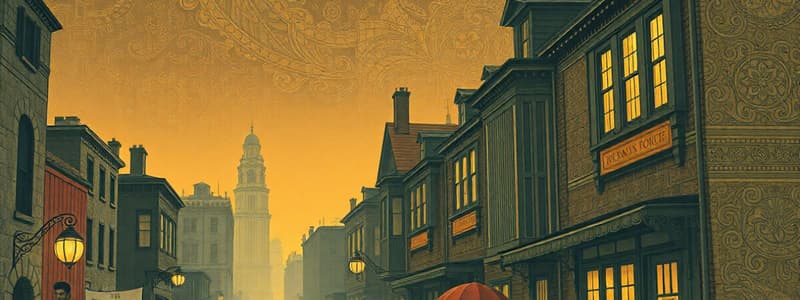Podcast
Questions and Answers
What was a significant economic factor that contributed to the Great Migration?
What was a significant economic factor that contributed to the Great Migration?
- Increased agricultural subsidies in the South
- Development of textile industries in the South
- Job opportunities in northern factories during WWI and WWII (correct)
- Exodus of Northern industries to the South
Which social factor influenced many African Americans to leave the South during the Great Migration?
Which social factor influenced many African Americans to leave the South during the Great Migration?
- Freedom to practice different religions
- Desire for better education and living conditions (correct)
- A national movement for land ownership
- Access to agricultural land
How did the Great Migration impact urban areas?
How did the Great Migration impact urban areas?
- Rapid increase in African American populations in northern cities (correct)
- Decreased job opportunities for white residents
- Reduction in urban infrastructure development
- Decline of manufacturing jobs in the North
What was a cultural impact of the Great Migration during the 1920s?
What was a cultural impact of the Great Migration during the 1920s?
Which of the following legacies resulted from the Great Migration?
Which of the following legacies resulted from the Great Migration?
What challenge continued to affect African Americans after the Great Migration?
What challenge continued to affect African Americans after the Great Migration?
What role did social movements play in the African American experience during and after the Great Migration?
What role did social movements play in the African American experience during and after the Great Migration?
In what way did the Great Migration permanently alter demographics in America?
In what way did the Great Migration permanently alter demographics in America?
Flashcards are hidden until you start studying
Study Notes
Causes Of The Great Migration
- Economic Factors:
- Job opportunities in northern factories during WWI and WWII.
- Decline of the agricultural economy in the South due to mechanization.
- Social Factors:
- Escaping racial segregation and Jim Crow laws in the South.
- Desire for better education and living conditions.
- Environmental Factors:
- Natural disasters in the South (e.g., floods, boll weevil infestation) damaging crops.
Impact On Urban Areas
- Demographic Changes:
- Rapid increase in African American populations in northern cities (e.g., Chicago, Detroit, New York).
- Urban Tensions:
- Racial tensions and violence, notably in race riots (e.g., Chicago Race Riot of 1919).
- Economic Contributions:
- Growth of the labor force contributing to industrialization.
- Establishment of vibrant businesses within African American communities.
Cultural Changes
- Harlem Renaissance:
- Flourishing of African American arts, literature, and music in the 1920s.
- Prominent figures: Langston Hughes, Zora Neale Hurston.
- Cultural Exchange:
- Fusion of African American culture with existing urban cultures.
- Influence on mainstream American culture, particularly in music (jazz, blues).
Legacy And Significance
- Civil Rights Movement Foundation:
- Set the stage for future civil rights activism.
- Raised awareness of racial inequalities in America.
- Urbanization of African Americans:
- Shift from rural to urban living patterns permanently altered demographics.
- Political Participation:
- Increased voter registration and political activism among African Americans.
African American Experience
- Identity and Community:
- Development of strong African American neighborhoods and cultures in urban areas.
- Struggles and Challenges:
- Continued discrimination and challenges in accessing quality jobs, housing, and education.
- Social Movements:
- Emergence of organizations advocating for civil rights, such as the NAACP.
- Resilience and Adaptation:
- Despite hardship, strengthening community ties through social networks and cultural expressions.
Causes of the Great Migration
- Economic Opportunities:
- World War I & II created job opportunities in industrializing northern cities, attracting Black workers from the South.
- Mechanized agriculture reduced the need for agricultural laborers in the South causing economic hardship.
- Social Factors:
- Escape from the Jim Crow era and rampant racism in the South, seeking a better life.
- Desire for better education and living conditions for themselves and their families.
- Environmental Factors:
- Southern crops were affected by recurring natural disasters like floods and the boll weevil infestation.
Impact on Urban Areas
- Population Growth:
- Rapid increase of Black communities in urban centers like Chicago, Detroit, and New York City.
- Racial Tension:
- Rise in racially motivated violence against Black people in cities, including riots like the Chicago Race Riot of 1919.
- Economic Contributions:
- Black workers became a significant labor force, driving industrial growth.
- Establishment of Black-owned businesses within urban neighborhoods.
Cultural Changes
- Harlem Renaissance:
- Flourishing of Black arts, literature, and music in the 1920s.
- Prominent figures like Langston Hughes and Zora Neale Hurston expressed Black culture during this period.
- Cultural Exchange:
- Fusion of Black culture with existing urban cultures.
- Black artistic expressions influenced mainstream American culture, particularly in music like jazz and blues.
Legacy and Significance
- Foundation for the Civil Rights Movement:
- The Great Migration highlighted racial inequalities in the US, inspiring future civil rights activism.
- Urbanization of African Americans:
- Shifted Black demographics from rural areas to urban centers, permanently affecting American society.
- Political Participation:
- The Great Migration spurred increased voter registration and political activism among Black Americans.
African American Experience
- Identity and Community:
- Development of strong Black communities and distinct cultures within urban areas.
- Struggles and Challenges:
- Despite contributing to the country's growth, Black Americans faced discrimination and challenges in accessing quality jobs, housing, and education.
- Social Movements:
- Emergence of organizations like the NAACP advocating for civil rights.
- Resilience and Adaptation:
- Black communities thrived in urban environments by developing strong social networks and cultural expressions.
Studying That Suits You
Use AI to generate personalized quizzes and flashcards to suit your learning preferences.




